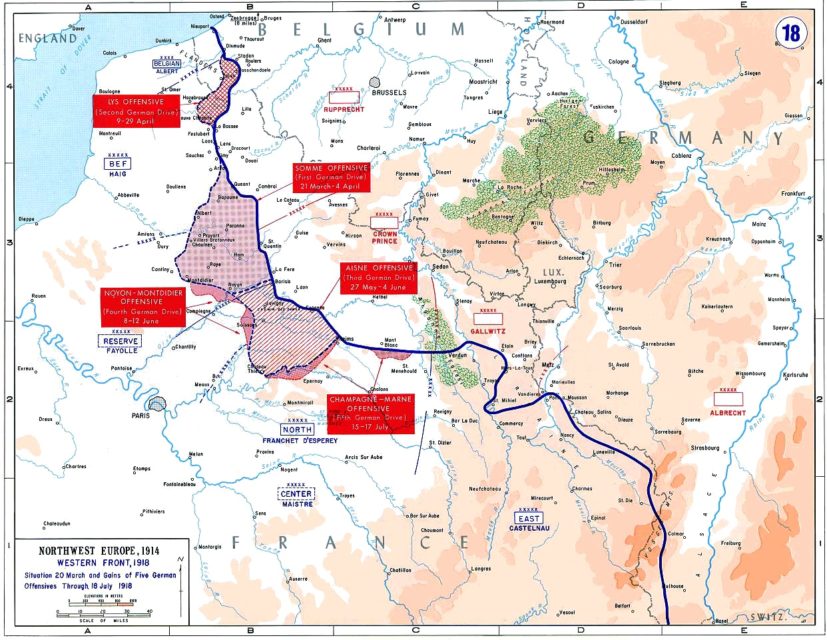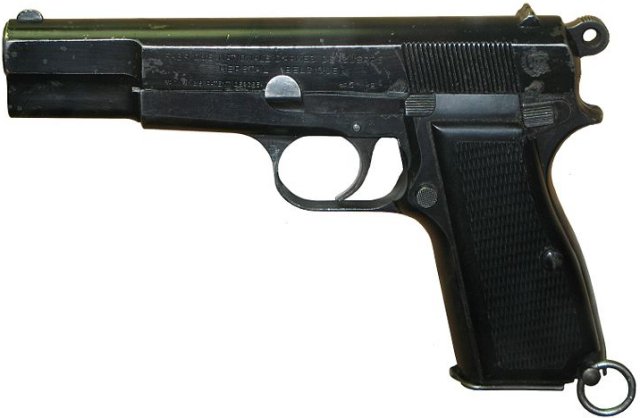The Great War
Published on 1 Sep 2018Chair of Wisdom Time!
September 2, 2018
Adrian Carton de Wiart – WW1 Paratroopers? I OUT OF THE TRENCHES
July 20, 2018
2nd Battle Of The Marne – Turning Point On The Western Front I THE GREAT WAR Week 208
The Great War
Published on 19 Jul 2018The German Army launches an diversionary attack from the Rheims-Soisson salient and increases the pressure on Paris. But the Allies knew about the attack and for the first time, they effectively counter the German Stormtrooper tactics and even counter-attack along the line.
July 10, 2018
Mountain Combat In The Vosges – The Battle For Alsace-Lorraine I THE GREAT WAR Special
The Great War
Published on 9 Jul 2018The Battle for Alsace-Lorraine in the Vosges was unforgiving and brutal. Both the French and the German troops were fighting in extreme conditions for a extremely symbolic stretch of land.
June 6, 2018
D-Day – I: The Great Crusade – Extra History
Extra Credits
Published on 6 Jun 2017D-Day: June 6, 1944, the day when Allied forces stormed the beaches of Normandy to retake France from the Germans. They hoped to take the Germans by surprise, and their decision to brave rough weather to make their landings certainly accomplished that, but despite these small advantages, the American forces at Utah and Omaha Beach had to overcome monumental challenges to establish a successful beachhead.
May 31, 2018
No5 MkI Enfield “Jungle Carbine”
Forgotten Weapons
Published on 18 Jan 2015http://www.forgottenweapons.com
The No.5 MkI Enfield, commonly called the “jungle carbine” is nearly the shortest-lived rifle in British military service. Introduced in 1944, they were declared obsolete in 1947 as the result of insoluble accuracy problems. The guns were originally developed from regular No4 Enfield rifles with the goal of producing a shorter and lighter variant for paratroops. This was done by shortening the barrel, adding a flash hider, and making lightening cuts in several places on the barrel and receiver (which were the cause of the problems that doomed the gun).
Not all No.5 rifles produced developed problems, and they were certainly handier than the regular Enfield rifles. They are noted for kicking harder, of course, and this is not really helped by the narrow rubber buttpad they came with (most of which are nice and hard today).
Theme music by Dylan Benson – http://dbproductioncompany.webs.com
May 29, 2018
Allied Defense During Spring Offensives 1918 I THE GREAT WAR Special
The Great War
Published on 28 May 2018MHV about Stormtrooper tactics: https://www.youtube.com/watch?v=BNqmA-if-4g
The French and British defenses during the German Spring Offensive 1918 were put to a real test when the Germans attacked. The carefully built defenses had to be abandoned and new lessons had to be learned.
April 17, 2018
Storm of Steel – Author And Officer Ernst Jünger I WHO DID WHAT IN WW1?
The Great War
Published on 16 Apr 2018Storm of Steel (In Stahlgewittern) by Ernst Jünger is one of the most harrowing German accounts of World War 1. The author was an officer on the Western Front and fought with the assault troops and stormtroopers until summer 1918.
March 23, 2018
Kaiserschlacht – German Spring Offensive 1918 I THE GREAT WAR Week 191
The Great War
Published on 22 Mar 2018It was all or nothing for the German Army under General Erich Ludendorff now: They unleashed the biggest offensive of the entire war on the Western Front trying to split the British and French Armies, drive the British off the continent and capture Paris.
March 16, 2018
The Imperial German Army’s final throw of the dice – Operation Michael, March 1918
Victor Davis Hanson summarizes the Central Powers’ brief moment of strength early in 1918:
One hundred years ago this month, all hell broke loose in France. On March 21, 1918, the German army on the Western Front unleashed a series of massive attacks on the exhausted British and French armies.
German General Erich Ludendorff thought he could win World War I with one final blow. He planned to punch holes between the French and British armies. Then he would drive through their trenches to the English Channel, isolating and destroying the British army.
The Germans thought they had no choice but to gamble.
The British naval blockade of Germany after three years had reduced Germany to near famine. More than 200,000 American reinforcement troops were arriving each month in France. (Nearly 2 million would land altogether.) American farms and factories were sending over huge shipments of food and munitions to the Allies.
Yet for a brief moment, the war had suddenly swung in Germany’s favor by March 1918. The German army had just knocked Russia and its new Bolshevik government out of the war. The victory on the Eastern Front freed up nearly 1 million German and Austrian soldiers, who were transferred west.
Germany had refined new rolling artillery barrages. Its dreaded “Stormtroopers” had mastered dispersed advances. The result was a brief window of advantage before the American juggernaut changed the war’s arithmetic.
The Spring Offensive almost worked. Within days, the British army had suffered some 50,000 casualties. Altogether, about a half-million French, British and American troops were killed or wounded during the entire offensive.
But within a month, the Germans were sputtering. They could get neither supplies nor reinforcements to the English Channel. Germany had greedily left 1 million soldiers behind in the east to occupy and annex huge sections of conquered Eastern Europe and western Russia.
The British and French had learned new ways of strategic retreat. By summer of 2018, the Germans were exhausted. In August, the Allies began their own (even bigger) offensive and finally crushed the retreating Germans, ending the war in November 1918.
For more information on Operation Michael, sometimes known as “The Kaiser’s Battle”, here’s the Wikipedia entry.
March 9, 2018
Devil’s Brigade – WWII First Special Service Force
farias615
Published on 24 May 2017
March 2, 2018
Ludendorff’s Window Of Opportunity I THE GREAT WAR Week 188
The Great War
Published on 1 Mar 2018German victory in the East, chaos in the British High Command, stable fronts in the Balkans and Italy, the US still not in full strength; German General Erich Ludendorff has a window of opportunity for his spring offensive and he intends to use it. Within the next weeks the German Army will launch their biggest offensive of WW1: Operation Michael.
February 28, 2018
Great Blunders of WWII: A Bridge Too Far 6
Anthony Coleman
Published on 4 Nov 2016From the History Channel DVD series “Great Blunders of WWII”
February 12, 2018
The Browning High Power pistol finally ends production after 82 years
Kyle Mizokami reported on this last week:
Small arms manufacturer Browning has ended production of the Browning Hi Power semiautomatic handgun. The legendary pistol served in armies worldwide, from Nationalist China to the British Special Air Service and was one of the first high capacity pistols ever invented. An invention of prolific arms designer John Moses Browning, the Hi Power was the inventor’s last pistol design.
As noticed by The Firearm Blog, the pistol‘s product page was quietly changed to include the words, “no longer in production” and the prices were removed. The Hi Power pistol was in continuous production for 82 years.
The Hi Power was the brainchild of American small arms legend John Moses Browning, a prolific inventor who also created the M2 .50 caliber machine gun, still in use with U.S. military forces today. He also invented the M1911 handgun, the U.S. military’s standard sidearm for nearly 70 years, and literally dozens of other pistols, shotguns, rifles, machine guns, and even a cannon. Browning was working on the Hi Power when he died in 1926, and the gun was eventually finished and sold by his manufacturing partners in Belgium in 1935.
The Hi Power had little in the form of commercial success before World War II, but was used by both sides during the war. Belgium’s surrender to Nazi Germany saw plans for the gun smuggled out of the country to Canada, where they were built for Nationalist Chinese forces and British and Canadian paratroopers and special forces. The tooling left behind in occupied Belgium went on to produce handguns for German military forces, particularly paratroopers and the Waffen SS. After the war the gun was sold to civilians and armed forces, particularly those belonging to NATO, and eventually more than 50 armies and 93 nations adopted the Hi Power as their standard sidearm. More than a million Hi Powers were eventually produced.
January 30, 2018
British Special Forces – Bulgarian-Ottoman Relations – Caporetto I OUT OF THE TRENCHES
The Great War
Published on 29 Jan 2018Ask your questions here: http://outofthetrenches.thegreatwar.tv
December 5, 2017
Origins Of The German Alpenkorps I THE GREAT WAR On The Road
The Great War
Published on 4 Dec 2017Get Immanuel’s book about the Alpenkorps in English: https://www.zeit-lupen.de/alpinecorps
When World War 1 broke out, the German Army didn’t really have troops specialised in mountain warfare. But by 1915, they brought together the first parts of the Alpenkorps. To train them, the troops were sent – in secrecy – to the new Italian front to learn from their Austrian counterparts. From May to October 1915 the Alpenkorps was forged in the Dolomites on the peaks with names like Lagazuoi, Col di Lana or Marmolata.





